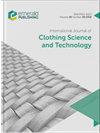服装行业裁剪订单计划问题的设计启发式方法
IF 1
4区 工程技术
Q3 MATERIALS SCIENCE, TEXTILES
International Journal of Clothing Science and Technology
Pub Date : 2024-05-17
DOI:10.1108/ijcst-07-2022-0087
引用次数: 0
摘要
目的近年来,服装需求大幅增加,要求制造商加快生产速度以吸引客户。裁剪订单计划(COP)是服装制造业最重要的流程之一。适当的网版安排可以降低成本,减少布料浪费。COP 问题的重点是确定样板的尺寸组合,而尺寸组合由裁剪台的长度、宽度、需求顺序和裁剪设备的高度决定。设计/方法/途径 本研究提出了新的启发式:遗传算法(GA)、共生体搜索、基于分而搜索的 Lite 启发式和逐一(ObO)启发式来解决 COP 问题。COP 问题的目标是确定钢网的最佳组合,以满足需求要求并最大限度地减少织物总长度。研究结果 对我们提出的启发式方法与其他基于模拟退火和 GA 的启发式方法以及混合方法(传统算法 + GA)进行了比较,以证明所提启发式方法的有效性和效率。测试结果表明,ObO 启发式能显著提高求解效率,并能在极端需求下找到近似最优解。结果表明,所提出的方法克服了确定模板匹配排列所需的较长操作时间。特别是,我们提出的 ObO 启发式能显著提高求解效率,即在极短的时间内找到极端需求的近似最优解。本文章由计算机程序翻译,如有差异,请以英文原文为准。
Design heuristics for cut order planning problems in the apparel industry
PurposeIn recent years, the demand for garments has significantly increased, requiring manufacturers to speed up their production to attract customers. Cut order planning (COP) is one of the most important processes in the apparel manufacturing industry. The appropriate stencil arrangement can reduce costs and fabric waste. The COP problem focuses on determining the size combination for a pattern, which is determined by the length of the cutting table, width, demand order, and height of the cutting equipment.Design/methodology/approachThis study proposes new heuristics: genetic algorithm (GA), symbiotic organism search, and divide-and-search-based Lite heuristic and a One-by-One (ObO) heuristic to address the COP problem. The objective of the COP problem is to determine the optimal combination of stencils to meet demand requirements and minimize the total fabric length.FindingsA comparison between our proposed heuristics and other simulated annealing and GA-based heuristics, and a hybrid approach (conventional algorithm + GA) was conducted to demonstrate the effectiveness and efficiency of the proposed heuristics. The test results show that the ObO heuristic can significantly improve the solution efficiency and find the near optimal solution for extreme demands.Originality/valueThis paper proposes a new heuristic, the One-by-One (ObO) heuristic, to solve the COP problem. The results show that the proposed approaches overcome the long operation time required to determine the fitting arrangement of stencils. In particular, our proposed ObO heuristic can significantly improve the solution efficiency, i.e. finding the near optimal solution for extreme demands within a very short time.
求助全文
通过发布文献求助,成功后即可免费获取论文全文。
去求助
来源期刊
CiteScore
2.40
自引率
8.30%
发文量
51
审稿时长
10 months
期刊介绍:
Addresses all aspects of the science and technology of clothing-objective measurement techniques, control of fibre and fabric, CAD systems, product testing, sewing, weaving and knitting, inspection systems, drape and finishing, etc. Academic and industrial research findings are published after a stringent review has taken place.

 求助内容:
求助内容: 应助结果提醒方式:
应助结果提醒方式:


